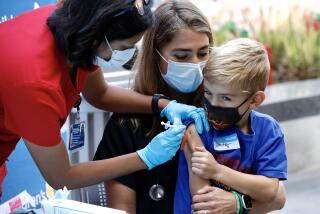$21 Inoculation Could Have Prevented a $46,500 Bill : Medicine: A new vaccine for young children has the potential of eventually eliminating bacterial meningitis.
- Share via
WASHINGTON — Dr. Henry Shinefield, a practicing pediatrician for more than 40 years, has seen firsthand the tragedy wrought by bacterial meningitis in young children.
“Many children die, or suffer permanent brain damage that results in mental retardation,” he said Friday. “It can be devastating for the children and their families, and very frustrating for a pediatrician.”
President Clinton did not exaggerate in describing the dramatic example of Rodney Miller, a young Miami child whose serious illness and hospitalization--and subsequent $46,500 medical bills--could have been prevented by a $21.48 inoculation, according to Shinefield and other experts.
The introduction of the newest version of the vaccine against the leading cause of bacterial meningitis--Haemophilus influenzae type B (HIB) bacteria--the first such vaccine available for infants as well as older children, is considered one of the great medical success stories of recent history.
It has the potential of eliminating the disease--if every child is vaccinated.
“This vaccine raises the possibility that we may totally eradicate this disease if enough kids get immunized,” said Dr. John La Montagne, director of the division of microbiology and infectious diseases for the federal government’s National Institute of Allergy and Infectious Diseases (NIAID). “Getting enough kids immunized is the problem.”
A single case of the disease can cost $50,000 or more to treat, experts said, and can still result in permanent disability. NIAID, which funded $17 million for research on the new vaccine, conservatively estimates that the product already results in savings of at least $400 million a year in health care costs--and has the potential to save considerably more.
HIB vaccine, like those that protect against polio, measles, mumps, rubella, pertussis, diphtheria and tetanus, is routinely recommended for all young children.
But until the late 1980s, the only approved HIB vaccine was effective only in children at least 18 months old. That was the earliest age that a child could be vaccinated against HIB.
But then, after literally working decades to create a better product--one that would work in younger children, especially babies--researchers finally developed a version--called a conjugate vaccine--that was successful in protecting infants against this childhood scourge.
It was approved by the Food and Drug Administration in stages--in 1987 first for use in children 15 months old and up--and then, in 1990, for babies ages 2 months and older.
The new vaccine, first developed and manufactured by Lederle-Praxis Biologicals, was viewed as a major medical advance--particularly since infants were among those most vulnerable to HIB, and physicians were often helpless in diagnosing and treating it in time.
Haemophilus influenzae type B is a highly contagious bacteria that infects the upper respiratory tract and may spread to the nervous system and bloodstream, causing extensive brain, spinal cord, bone and joint damage. It attacks one of every 200 children in the United States before the age of 5.
Its most common manifestation is meningitis, an inflammation of the membranes that surround the brain and spinal cord that can cause death and mental retardation and can leave young children blind, deaf or paralyzed.
The bacteria also causes another life-threatening condition called epiglottitis, which is an inflammation of the lid over the voice box.
“The prospect of having HIB disease reduced to almost nothing fills pediatricians with unconfined joy,” said Shinefield, co-director of Kaiser Permanente’s pediatric vaccine study center in Oakland and San Francisco and one of the researchers who conducted the key clinical trials that led to its approval. “This was a vaccine that was sorely needed.”
Even in the last five years, incidence of the disease has declined a dramatic 71% as a result of the new vaccine, according to the Centers for Disease Control and Prevention.
“This vaccine has really worked very rapidly to cause a major reduction in this cause of meningitis,” said Dr. Jay Wenger, of the CDC’s meningitis special pathogens branch. “Seventy-one per cent in such a short period of time is a major public health success story.”
Before 1987, various annual estimates of HIB disease ranged from 12,000 to 20,000 cases. In 1991, there were fewer than 2,000, Wenger said. “It really is quite remarkable,” he said.
Shinefield has seen similar declines in his own region. “In 1992, instead of having an average of 70 cases, we had only one--and that was in an unvaccinated child.”
The vaccine, which is typically given in a four-dose series at 2, 4, 6, and 15 months of age, is sold by the manufacturers to pediatricians for about $15 a dose. Pediatricians typically mark up the price, sometimes as much as twofold, according to Lederle officials.
The $15 manufacturers’ price for HIB shots is comparable to other childhood vaccines, according to the House Energy and Commerce subcommittee on health. DPT shots, which are given in a series at intervals similar to HIB, sell for $10 a dose, and are followed at age 5 by a booster inoculation; polio vaccine costs $10 a dose and is given twice orally; and a single combination measles, mumps and rubella vaccination costs about $15.
“This can be a lot of money for marginal income kids, or even for middle income people whose insurance does not cover immunizations,” said one House source who has worked on vaccine legislation. “But it’s much better than having your kid run the risk of getting sick with any of these diseases.”






